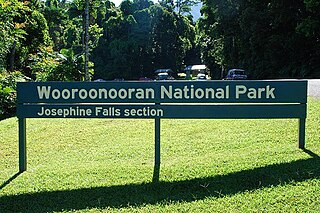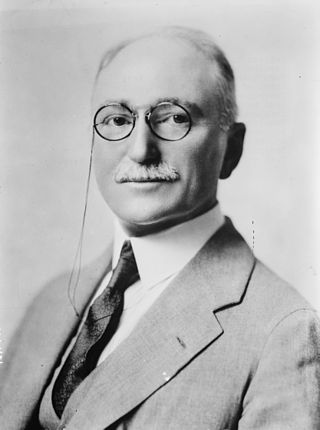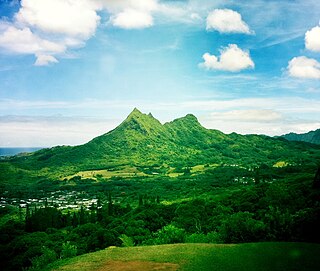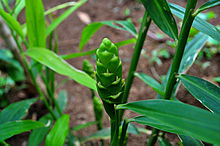
Honolulu is the capital and most populous city of the U.S. state of Hawaii, which is in the Pacific Ocean. It is the unincorporated county seat of the consolidated City and County of Honolulu, situated along the southeast coast of the island of Oʻahu, and is the westernmost and southernmost major U.S. city. Honolulu is Hawaii's main gateway to the world. It is also a major hub for business, finance, hospitality, and military defense in both the state and Oceania. The city is characterized by a mix of various Asian, Western, and Pacific cultures, reflected in its diverse demography, cuisine, and traditions.

Wooroonooran National Park is a national park in Queensland, Australia, 1,367 km northwest of Brisbane, between Innisfail and Cairns.

The University of Hawaiʻi System, formally the University of Hawaiʻi and popularly known as UH, is a public college and university system that confers associate, bachelor's, master's, and doctoral degrees through three universities, seven community colleges, an employment training center, three university centers, four education centers and various other research facilities distributed across six islands throughout the state of Hawaii in the United States. All schools of the University of Hawaiʻi system are accredited by the Western Association of Schools and Colleges. The UH system's main administrative offices are located on the property of the University of Hawaiʻi at Mānoa in Honolulu CDP.

Maunalua is a largely residential area located in the City & County of Honolulu, in the East Honolulu CDP, on the island of Oʻahu. Maunalua is the largest of several communities at the eastern end of the island. The area was largely developed by Henry J. Kaiser around the ancient Maunalua fishpond and wetlands area known as Kuapā. The Hawaiʻi Kai or Koko Marina was dredged from Kuapā Pond starting around 1959. Dredging not only transformed the shallow coastal inlet and wetlands into a marine embayment, but was accompanied by considerable filling and clearing of the pond margins. In 1961, Kaiser-Aetna entered into a lease agreement with the land owner, the Bernice Pauahi Bishop Estate, to develop the 521 acre (2.11 km2) fishpond into residential tracts with a marina and channels separated by fingers of land and islands upon which house lots and commercial properties would be laid out and developed. Nearly all of the low-lying lands surrounding the marina have since been developed, and neighborhoods now extend back into the several valleys and up the separating ridges.
The following is an alphabetical list of articles related to the U.S. state of Hawaii:

Wallace Rider Farrington was an American journalist who served as the sixth Territorial Governor of Hawaii, serving from 1921 to 1929. Prior to his term, he was editor of The Honolulu Advertiser and Honolulu Star-Bulletin newspapers.

Mānoa is a valley and a residential neighborhood of Honolulu, Hawaiʻi. The neighborhood is approximately three miles (5 km) east and inland from downtown Honolulu and less than a mile from Ala Moana and Waikiki at 21°18.87916′N157°48.4846′W.

ʻAkaka Falls State Park is a state park on Hawaiʻi Island, in the U.S. state of Hawaii. The park is about 11 miles (18 km) north of Hilo, west of Honomū off the Hawaii Belt Road at the end of Hawaii Route 220. It includes its namesake ʻAkaka Falls, a 442-foot (135 m) tall waterfall. ʻAkaka is named after Chief 'Akaka-o-ka-nī'au-oi'o-i-ka-wao, grandson of Kūlanikapele and Kīakalohia. The accessible portion of the park lies high on the right shoulder of the deep gorge into which the waterfall plunges, and the falls can be viewed from several points along a loop trail through the park. Also visible from this trail is Kahūnā Falls, a 300-foot (91 m) tall waterfall, and several smaller cascades.

Foster Botanical Garden, measuring 13.5 acres (5.5 ha), is one of five public botanical gardens on Oahu. It is located at 50 North Vineyard Boulevard, Honolulu, Hawaii, United States, near Chinatown at the intersection of Nu'uanu Avenue and Vineyard Boulevard. Foster is in a highly urban area with strip malls, schools, and Buddhist, Shinto, and Methodist religious facilities nearby.

The Harold L. Lyon Arboretum is a 200-acre (0.8 km2) arboretum and botanical garden managed by the University of Hawaiʻi at Mānoa located at the upper end of Mānoa Valley in Hawaiʻi.

Sacred Falls State Park is a closed state park located in Hauʻula on the North Shore of the Hawaiian island of Oʻahu. It has been closed since the rockfall that occurred on Mother's Day in 1999. Although people caught entering the park are subject to hefty fines, hikers continue to trespass into the park. The park encompasses Kaluanui gulch and the waterfalls at its end. It is a wahi pana in the district (moku) of Koʻolauloa, with much associated Hawaiian lore:

The Kalalau Valley is located on the northwest side of the island of Kauaʻi in the state of Hawaiʻi. The valley is located in the Nā Pali Coast State Park and houses the Kalalau Beach. The Nā Pali Coast is rugged and is inaccessible to automobiles. The only legal ways to access the valley are by kayak or by hiking the Kalalau Trail.

Ahupuaʻa O Kahana State Park, formerly Kahana Valley State Park, is located on the windward side of Oʻahu between Kaʻaʻawa and Punaluʻu in the state of Hawaii. The park is located mauka from Kahana Bay. It is Hawaii's only public ahupuaʻa, and it stretches from the sea to the tip of Puʻu Pauao at 2670 feet. It has a tropical climate, and it is one of the wettest areas in Oʻahu, averaging nearly 300 inches per year in parts of the valley. The main purpose of the park is to embrace and teach Hawaiian culture.

ʻŌpaekaʻa Falls is a waterfall located on the ʻŌpaekaʻa Stream in Wailua River State Park on the eastern side of the Hawaiian island of Kauai. It is a 151-foot (46 m) waterfall that flows over basalt from volcanic eruptions millions of years ago. Below the ridge down into the ravine through which the water falls can be seen the vertical dikes of basalt that cut through the horizontal Koloa lava flows. The name "ʻŌpaekaʻa" means rolling shrimp, "ʻopae" being Hawaiian for "shrimp," and "kaʻa" for "rolling". The name dates back to days when the native freshwater shrimp Atyoida bisulcata were plentiful in the stream and were seen rolling and tumbling down the falls and into the churning waters at the fall's base.
Edward Leonard Caum (1893–1952) was a United States botanist known for his work on plant species in Hawaii.
Hawaii is one of the few U.S. states where coffee production is a significant economic industry – coffee is the second largest crop produced there. The 2019–2020 coffee harvest in Hawaii was valued at $102.9 million. As of the 2019-2020 harvest, coffee production in Hawaii accounted for 6,900 acres of land

Olomana is a set of three mountainous peaks on the windward side of Oahu near Kailua and Waimanalo. While historically only the first peak was called Olomana and the second and third Paku'i and Ahiki respectively, most people call the entire section Olomana. Geologically speaking, Olomana is an erosional remnant from within the caldera of the Koʻolau Volcano.

Mānoa Falls Trail is a 1.6-mile (2.6 km) trail on the island of Oahu in Hawaii. The trail is a part of the Honolulu Makau Trail System, and leads to a popular 150 foot waterfall called Manoa Falls. Hiking the trail is approximately a one-hour round trip. Many tourists are attracted to the waterfall and scenery throughout the trail. The trails have a history as one of the earlier Hawaiian trails. There are many legends of the Night Marchers, or ancient Hawaiian warriors associated with Manoa Falls. Scenes in movies such as Jurassic Park and Catching Fire were filmed at Manoa Falls. The Manoa Falls trail harbors many plant species and tropical birds as well. The Lyon Arboretum, located in the Manoa Valley at the base of the trail is another popular tourist attraction and aims to preserve endangered Hawaiian plants. Some may say that this trail is "Easy". However, there is currently no formal way of rating trails. Therefore, since the trail can be very slippery when wet the rating can be subjective. Thus, users should use caution on any trail and turn around if not comfortable. Rain showers are very common on the trail and the path to the waterfall is often muddy and slippery. Flash floods may also occur at any time. Swimming in the pools of water on the trail is highly discouraged due to the threat of Leptospirosis.
Wayne Arthur Whistler was an American ethnobotanist, academic and writer. Whistler, an adjunct professor at the University of Hawaii's Department of Botany, was an expert on tropical flora of the Pacific Islands, especially Samoa and Tonga.
Beatrice Kapua'Okalani H. Krauss was a haole botanist, teacher, and historian from Hawai'i who specialized in the indigenous flora and ethnobotany of the islands.
















